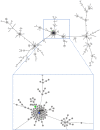Search for carbapenem-resistant bacteria and carbapenem resistance genes along swine food chains in Central Italy
- PMID: 38181018
- PMCID: PMC10769077
- DOI: 10.1371/journal.pone.0296098
Search for carbapenem-resistant bacteria and carbapenem resistance genes along swine food chains in Central Italy
Abstract
The presence of carbapenem-resistant bacteria and carbapenem resistance genes (CRGs) in livestock is increasing. To evaluate the presence of carbapenemase-producing Enterobacteriaceae (CPE) and the main CRGs along swine food chains of the Marche Region (Central Italy), samples of faeces, feed, and animal-food derived products were collected from seven small/medium, medium, and large-scale pig farms. A total of 191 samples were analysed using a culture-dependent method, with the aim of isolating CPE. Isolates were analysed for their resistance to carbapenems using a modified Hodge test and the microdilution method for the minimum inhibitory concentration (MIC) determination. Moreover, the extraction of microbial DNA from each sample was performed to directly detect selected CRGs via qPCR. Among the 164 presumptive resistant isolates, only one strain from a liver sample, identified as Aeromonas veronii, had an ertapenem MIC of 256 μg/mL and carried a carbapenemase- (cphA) and a β-lactamase- (blaOXA-12) encoding genes. A low incidence of CRGs was found; only nine and four faecal samples tested positive for blaNDM-1 and blaOXA-48, respectively. Overall, the importance of monitoring CPE and CRGs in livestock and their food chains should be stressed to control all potential non-human CPE and CRGs reservoirs and to determine safety levels for human health.
Copyright: © 2024 Garofalo et al. This is an open access article distributed under the terms of the Creative Commons Attribution License, which permits unrestricted use, distribution, and reproduction in any medium, provided the original author and source are credited.
Conflict of interest statement
The authors have declared that no competing interests exist.
Figures


Similar articles
-
Maintenance of Carbapenemase-Producing Enterobacteriaceae in a Farrow-to-Finish Swine Production System.Foodborne Pathog Dis. 2018 Jun;15(6):372-376. doi: 10.1089/fpd.2017.2355. Epub 2018 Mar 15. Foodborne Pathog Dis. 2018. PMID: 29638168
-
Carbapenem-Resistant Bacteria Recovered from Faeces of Dairy Cattle in the High Plains Region of the USA.PLoS One. 2016 Jan 29;11(1):e0147363. doi: 10.1371/journal.pone.0147363. eCollection 2016. PLoS One. 2016. PMID: 26824353 Free PMC article.
-
Carbapenemase-Producing Carbapenem-Resistant Enterobacteriaceae from Bangkok, Thailand, and Their Detection by the Carba NP and Modified Carbapenem Inactivation Method Tests.Microb Drug Resist. 2018 Sep;24(7):1006-1011. doi: 10.1089/mdr.2018.0080. Epub 2018 May 21. Microb Drug Resist. 2018. PMID: 29782216
-
Prevalence and Characteristics of Extended-Spectrum-β-Lactamase-Producing and Carbapenemase-Producing Enterobacteriaceae from Freshwater Fish and Pork in Wet Markets of Hong Kong.mSphere. 2020 Apr 15;5(2):e00107-20. doi: 10.1128/mSphere.00107-20. mSphere. 2020. PMID: 32295872 Free PMC article.
-
[Carbapenem resistance in ESBL positive Enterobacteriaceae isolates causing invasive infections].Mikrobiyol Bul. 2014 Jan;48(1):59-69. Mikrobiyol Bul. 2014. PMID: 24506716 Turkish.
Cited by
-
A Review of the Diagnostic Approaches for the Detection of Antimicrobial Resistance, Including the Role of Biosensors in Detecting Carbapenem Resistance Genes.Genes (Basel). 2025 Jun 30;16(7):794. doi: 10.3390/genes16070794. Genes (Basel). 2025. PMID: 40725449 Free PMC article. Review.
-
Antimicrobial Resistance in the WHO African Region: A Systematic Literature Review 2016-2020.Antibiotics (Basel). 2024 Jul 17;13(7):659. doi: 10.3390/antibiotics13070659. Antibiotics (Basel). 2024. PMID: 39061341 Free PMC article. Review.
-
Impact of Dietary Inputs on Carbapenem Resistance Gene Dynamics and Microbial Safety During Bioconversion of Agri-Food Waste and Anaerobic Digestate by Hermetia illucens Larvae.Genes (Basel). 2025 Jul 29;16(8):907. doi: 10.3390/genes16080907. Genes (Basel). 2025. PMID: 40869956 Free PMC article.
References
-
- EFSA BIOHAZ Panel. Scientific Opinion on Carbapenem resistance in food animal ecosystems. EFSA J. 2013;11(12):3501. doi: 10.2903/j.efsa.2013.3501 - DOI
-
- Roschanski N, Friese A, von Salviati-Claudiusa C, Heringb J, Kaesbohrerc A, Kreienbrockb L, et al.. Prevalence of carbapenemase producing Enterobacteriaceae isolated from German pig-fattening farms during the years 2011–2013. Vet Microbiol. 2017; 200:124–129. doi: 10.1016/j.vetmic.2015.11.030 - DOI - PubMed
MeSH terms
Substances
LinkOut - more resources
Full Text Sources
Research Materials
Miscellaneous

